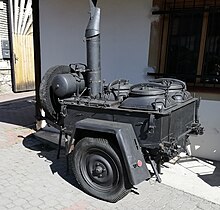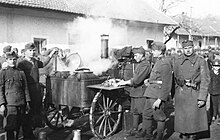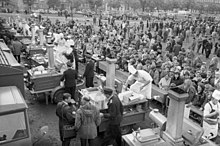
Containerization is a system of intermodal freight transport using intermodal containers. Containerization, also referred as container stuffing or container loading, is the process of unitization of cargoes in exports. Containerization is the predominant form of unitization of export cargoes, as opposed to other systems such as the barge system or palletization. The containers have standardized dimensions. They can be loaded and unloaded, stacked, transported efficiently over long distances, and transferred from one mode of transport to another—container ships, rail transport flatcars, and semi-trailer trucks—without being opened. The handling system is mechanized so that all handling is done with cranes and special forklift trucks. All containers are numbered and tracked using computerized systems.

An intermodal container, often called a shipping container, or a freight container, (or simply “container”) is a large standardized container designed and built for intermodal freight transport, meaning these containers can be used across different modes of transport – such as from ships to trains to trucks – without unloading and reloading their cargo. Intermodal containers are primarily used to store and transport materials and products efficiently and securely in the global containerized intermodal freight transport system, but smaller numbers are in regional use as well. It is like a boxcar that does not have wheels. Based on size alone, up to 95% of intermodal containers comply with ISO standards, and can officially be called ISO containers. These containers are known by many names: cargo container, sea container, ocean container, container van or sea van, sea can or C can, or MILVAN, or SEAVAN. The term CONEX (Box) is a technically incorrect carry-over usage of the name of an important predecessor of the ISO containers: the much smaller steel CONEX boxes used by the U.S. Army.

The Meal, Ready-to-Eat (MRE) is a self-contained individual United States military ration used by the United States Armed Forces and Department of Defense. It is intended for use by American service members in combat or field conditions where other food is not available. MREs have also been distributed to civilians as humanitarian daily rations during natural disasters and wars.
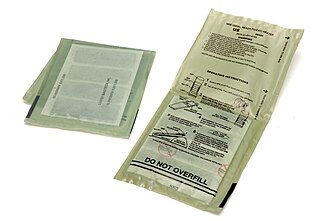
A flameless ration heater (FRH), colloquially an MRE heater, is a form of self-heating food packaging included in U.S. military Meal, Ready-to-Eat (MRE) rations since 1993.
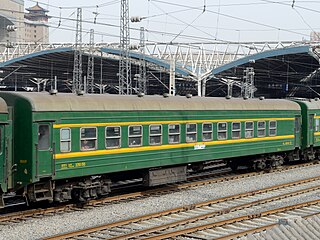
A railroad car, railcar, railway wagon, railway carriage, railway truck, railwagon, railcarriage or railtruck, also called a train car, train wagon, train carriage or train truck, is a vehicle used for the carrying of cargo or passengers on a rail transport network. Such cars, when coupled together and hauled by one or more locomotives, form a train. Alternatively, some passenger cars are self-propelled in which case they may be either single railcars or make up multiple units.

A Combat Support Hospital is a type of modern United States Army field hospital. The CSH is transportable by aircraft and trucks and is normally delivered to the Corps Support Area in standard military-owned demountable containers (MILVAN) cargo containers. Once transported, it is assembled by the staff into a tent hospital to treat patients. Depending upon the operational environment, a CSH might also treat civilians and wounded enemy soldiers. The CSH is the successor to the Mobile Army Surgical Hospital (MASH).

A mess kit is a collection of silverware and cookware designed for use by military personnel for food and military rations. They may also be used during camping and backpacking. There are many varieties of mess kits that militaries issue to their personnel that later become available to consumers.

United States military ration refers to the military rations provided to sustain United States Armed Forces service members, including field rations and garrison rations, and the military nutrition research conducted in relation to military food. U.S. military rations are often made for quick distribution, preparation, and eating in the field and tend to have long storage times in adverse conditions due to being thickly packaged or shelf-stable.

A chuckwagon or chuck wagon is a horse-drawn wagon operating as a mobile field kitchen and frequently covered with a white tarp, also called a camp wagon or round-up wagon. It was historically used for the storage and transportation of food and cooking equipment on the prairies of the United States and Canada. They were included in wagon trains for settlers and traveling workers such as cowboys or loggers. In modern times, chuckwagons feature in special cooking competitions and events. Chuckwagons are also used in a type of competition known as chuckwagon racing.

A food truck is a large motorized vehicle or trailer equipped to store, transport, cook, prepare, serve, and/or sell food.

The K-ration was a United States military ration consisting of three separately boxed meal units: breakfast, dinner, and supper. It was originally intended as an individually packaged daily ration for issue to airborne troops, tank crews, motorcycle couriers, and other mobile forces for short durations.

A field hospital is a temporary hospital or mobile medical unit that takes care of casualties on-site before they can be safely transported to more permanent facilities. This term was initially used in military medicine, but it has also been used to describe alternate care sites used in disasters and other emergency situations.

A field ration is a type of prepackaged military ration designed to be easily and quickly prepared and consumed in the field, in combat, at the front line, or where eating facilities are otherwise unavailable. Field rations are primarily used by military forces, though they are also sometimes distributed to civilians as part of humanitarian aid and emergency management. They differ from garrison rations and field kitchen provisions, which are intended for where proper meals can be supplied and prepared with relative ease and safety, such as in the rear where logistics are steady and fresh food can be supplied. They are similar to, but distinct from, other purpose-designed long-lasting types of food or rations such as emergency rations, humanitarian daily rations, and camping food.

The Individual Meal Pack or IMP is one type of field ration used by the Canadian Forces. The IMP is designed so that a continuous diet provides all the nutrition needed to sustain a service member in the field. The IMP meets Canada's nutrition requirements, with the exception of calcium and folic acid, which are not significant if the consumption period of rations is less than 30 (consecutive) days. IMPs provide 1,200–1,400 calories (5.0–5.9 MJ) per meal.
The 5-in-1 ration was a United States military ration issued from 1942 to the end of World War II. As its name implies, the 5-in-1 provided the needs of five soldiers in a single ration package. Procurement ended with the war, though remaining stocks were issued to troops after the war, as well as distributed as surplus in civilian feeding programs overseas. The 5-in-1 specification remained in effect after the war, and was again used in 1948 for a new field ration.

The A-ration is a United States military ration consisting of fresh, refrigerated, or frozen foods. A-rations may be served in dining facilities, prepared in the field using field kitchens, or prepared at a fixed facility and transported to field locations in containers. Its modern successor is the Unitized Group Ration – A (UGR-A), which combines multiple types of rations, including the A-ration, under one unified system.

Military rations, operational rations, or military provisions are goods issued to sustain the needs of military personnel. As their name suggests, military rations have historically been, and often still are, subject to rationing, with each individual receiving specific amounts from available supplies. Military-issued goods and the rationing of such goods has existed since the beginnings of organized warfare.
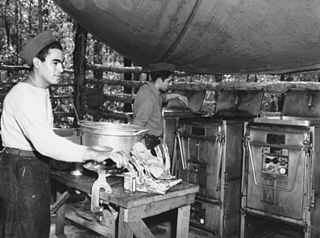
The B-ration was a United States military ration consisting of packaged and preserved food intended to be prepared in field kitchens by cooks. Its modern successor is the Unitized Group Ration – M (UGR-M), which combines multiple types of rations, including the B-ration, under one unified system.
Force Provider is a deployable bare base support system developed by the United States Army to provide rest and relief facilities for soldiers. Each containerized package provides air conditioned/heated billeting, dining, laundry, latrine and recreational facilities for a battalion-sized force of up to 550 soldiers and the 50 personnel required to operate it. Based around the use of TEMPER tents, it includes the capability to store and distribute 80,000 gallons of water, 40,000 gallons of fuel, and generate 1.1 megawatts of continuous power. It takes on average three to four days to prepare a Force Provider camp site, typically 10 acres of land, then five to six days to set it up and make the camp operational. Six packages can be combined to support a brigade-size force of 3,300 soldiers. Although its primary mission is to support front-line soldiers, Force Provider can be utilized for other missions such as humanitarian aid and disaster relief.

The Unitized Group Ration (UGR) is a United States military ration used by the United States Armed Forces and Department of Defense (DoD). It is intended to sustain groups of American service members with access to a field kitchen, serving as a field ration and a garrison ration. It is the modern successor to several older alphabetized rations—namely the A-ration, B-ration, and T-ration—combining them under a single unified system. UGRs are designed to meet the Military Daily Recommended Allowance when averaged over a 5 to 10 day period, with each meal providing between 1,300 and 1,450 kcal.
